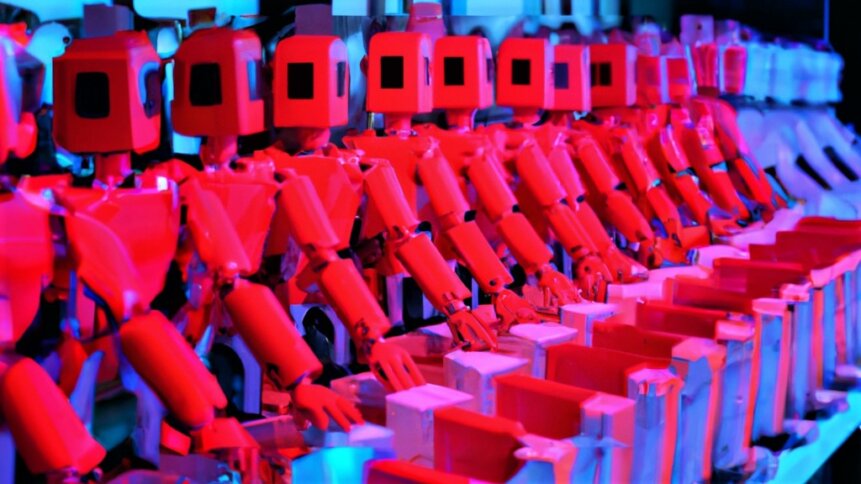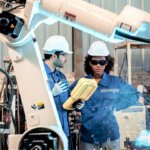Blockchain token economy secures swarm robots

The self-organizing behavior of swarm robots is beneficial in many ways, from building smarter tunnels and conducting remote surveys to paving the way for advanced rescue missions. But what happens when one of those robots goes rogue or breaks down? How can the collective intelligence of the swarm fight back against bad actors in the pack? The answer, according to an increasing number of experts, is smart contracts – using the principles of a blockchain token economy to secure robot swarms.
Publishing their results in the latest issue of Science Robotics, researchers based at IRIDIA – the Artificial Intelligence research laboratory of the Université Libre de Bruxelles – have shown how rationing ‘crypto tokens’ can neutralize discrepancies between the intended and actual behavior of swarm robots. “This discrepancy can be a result of programming errors, failed components, or malicious attacks,” writes the team.
Swarm robot security
In a demonstration using 24 Pi-puck robots, which feature Raspberry Pi Zero W hardware, the AI group implemented a ‘proof-of-authority consensus algorithm’ to govern the behavior of the swarm. Robots communicated with each other according to a smart contract – a computer program stored on a blockchain framework. “Each robot owned crypto tokens that it could spend to participate in security-critical swarm activities by sending transactions to the smart contract,” explain the developers.
Tokens were allocated at exponentially increasing time intervals to all of the swarm robots, much like a universal basic income, which allowed the group to communicate. But the smart contract was set up to only reward members for sending ‘good’ transactions, with no top-up available for undesirable actions. And the reward structure meant that malicious or malfunctioning robots soon ran out of tokens, leaving them without funds to send transactions and unable to influence swarm behavior.
The use of a blockchain token economy to secure robot swarms has been gaining ground for a number of years, with simulations yielding promising results. And the latest results show how such a framework can be applied in the real world.

Demo time: Pi-puck robots use their swarm intelligence to measure white pixels. Bad data is mitigated by using smart contracts to reward transactions that are beneficial to the task. Image credit: V. Strobel, A. Pacheco, & M. Dorigo.
Top 3 benefits of swarm robots –
- Operating as a large group, swarm robots are capable of complex behavior. Inspiration includes ants, bees, and other creatures that can team up and organize themselves to achieve great feats.
- Many simple robots are easier and cheaper to design and build compared with coming up with a solution based on a single device.
- Redundancy and resilience: operations can continue even if some members of the robot swarm suffer mechanical failure or have an electrical fault. And, as we’ve seen, blockchain technology can mitigate against security issues.
The small size of swarm robots allows them to move through dense and otherwise hard-to-navigate areas such as forests, where they can gather ecological information. Engineers in China have shown how 10 flying micro-drones, each weighing less than a full can of Pepsi, can collaboratively survey an outdoor area – even in the presence of moving obstacles and with human interference.
Each individual robot may appear relatively simplistic, but the power of the group acts as a multiplier – an effect often seen in nature. Tim Landgraf – a German researcher who’s been studying bees for coming up to 20 years – notes that while an individual bee has a brain the size of a pinhead, the insects can navigate a radius of up to 6km around their hives. “They act collectively as a network of tiny brains linked together through various forms of communication,” he comments. “They are sharing information, but also energy.”
The power of swarm intelligence inspired Landgraf to co-found the Dahlem Center for Machine Learning and Robotics in Berlin, where he and his colleagues apply bee-smarts to solve technology roadblocks in self-driving cars and other industrial sectors. And nature has much to teach device-makers about how to improve their products.
Ants can build dynamic bridges out of themselves to allow other ants to cross gaps. What’s more, the assemblies can compensate for movements in the foundations if the structure happens to be built on unstable materials such as leaves. And this hints at some of the applications for swarm robots – complex and harsh terrains.
Tomorrow at 4pm BST check out our careers panel, "How do I start a career in robotics?". Ask questions to our panel of roboticists from academia and industry.
Watch live on YouTube or Twitch:https://t.co/Kz3O4x8aCQhttps://t.co/hJDj4IXl2d#UKFR #RobotFest #Careers #Robotics pic.twitter.com/NEMpWppYS7
— UKRobotics (@UKRobotics) June 19, 2023
Swarm robots have huge potential in rescue operations. On TechHQ we’ve written about how chemical-sensing smart dust could travel large distances to register signs of life. But robot swarms can assist in other ways too. Radhika Nagpal, head of the Self-Organizing Systems Research Group at Harvard University, US, points out that swarm robots could potentially help to shore up a collapsing structure by building a supporting framework out of their bodies.
In construction, swarm robots provide the opportunity to build tunnels from the outside in. And again, looking at nature, termites have long proven to be expert tunnel builders, using their own saliva to bind soil and wood to reinforce their structures. UK-based swarm robotics operator hyperTunnel – which lists NetworkRail as a strategic partner – has its own take on this concept by injecting ground-improving chemistry to 3D print tunnel supports in-situ.
Data forensics
Returning to the application of blockchain technology to swarm robotics, it’s worth mentioning that having a digital ledger confers other rewards too. “During the autonomous operation of the robot swarm, a conflict-free logbook of the messages exchanged is automatically stored in the blockchain,” reports the IRIDIA team. “This logbook could be used for establishing accountability and for performing postliminary investigation and data forensics because the blockchain offers non-repudiation.”
Demonstrating how security frameworks keep robots accountable for their actions will help to build trust in the use of self-organizing swarms of devices. There’s also risk versus reward to consider. Having robot swarms carry out search and rescue missions, holding up damaged buildings to prevent further loss of life in environments that are too dangerous for humans to enter, is unlikely to meet with many objections.









